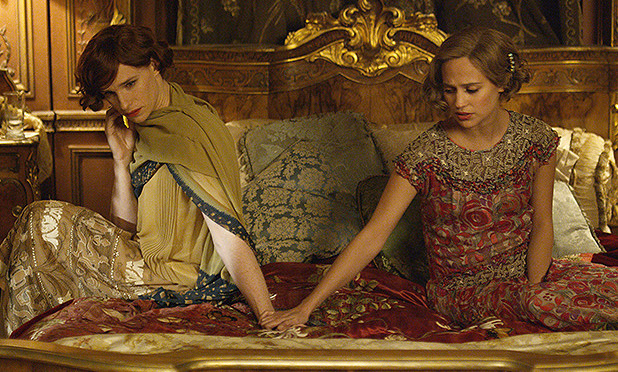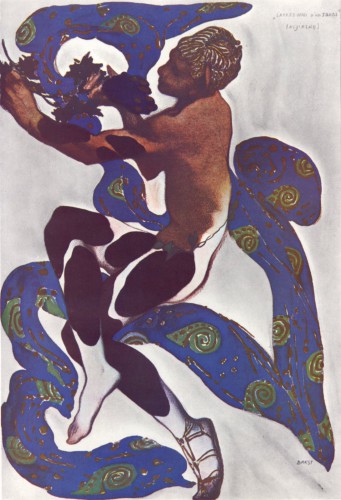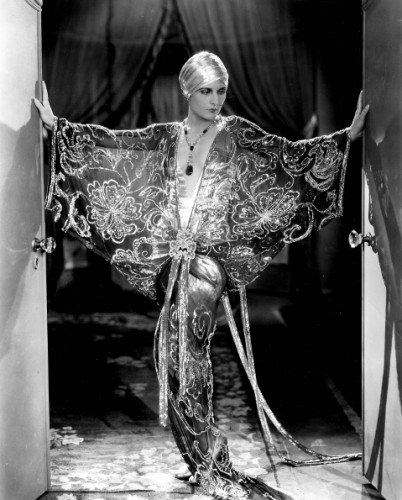The Academy Awards nominees for Costume Design for the movies of 2015 make for a very competitive if diverse field. Mountain men and polecats, princess and trans woman, lesbians and Vuvalini. For costume designer Sandy Powell – she will even be competing against herself, as she has two nominated contenders: Carol and Cinderella. The five nominees are:
1) Carol 2) Cinderella 3) The Danish Girl 4) Mad Max: Fury Road 5) The Revenant
CAROL was designed by Sandy Powell. It stars Cate Blanchett and Rooney Mara in a 1950s era lesbian relationship between a well-off housewife and a young department store sales clerk. The director Todd Haynes and Sandy Powell wanted to stay true to the 1952 New York setting of the Patricia Highsmith novel. So they looked at the photos of Vivian Maier, Ruth Orkin, and Saul Leiter. Sandy remarked that 1952 fashion was much like late 1940s fashion.
Sandy also went through old Vogue magazines from 1952. Most all of the photography was in black and white, but the designer injected some color into the otherwise monotone yet elegant fashion of the time.

Although the large mink coat looks vintage, it was made custom from recycled fur for the shape and color that Sandy Powell desired.
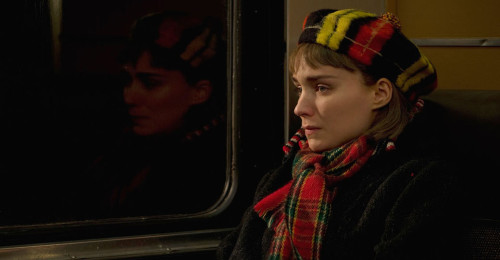
Sandy Powell has been nominated eleven times for a best costume design Oscar, for which she won three awards: Shakespeare in Love (1998); The Aviator (2004); and for The Young Victoria (2009).
CINDERELLA was also designed by Sandy Powell. The classic fairy tale was brought to the screen by Disney as a live action movie starring Lily James as Cinderella, Cate Blanchett as the evil step-mother Lady Tremaine, Helena Bonham Carter as the Fairy-Godmother and Richard Madden as the Prince. The gowns for the movie reportedly used some 1.7 million Swarovsky crystals. Costume designer Sandy Powell was inspired by the 19th century for the look and silhouette of the costumes. “It felt most like a fairy tale world.” she said.
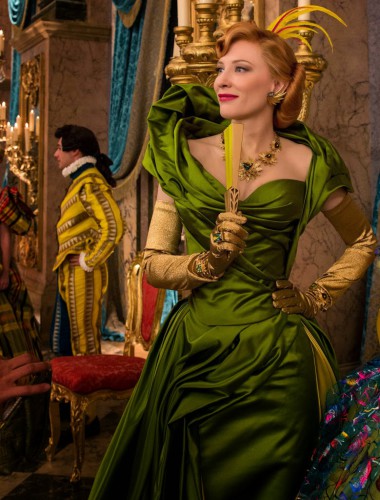
For Cate Blanchett’s costumes as the evil-stepmother/Lady Tremaine, Sandy Powell used cool colors, colors like green or jewel colors but that were not “friendly,”

Cate Blanchett’s wardrobe was based on the more powerful 1940s silhouette and the idea of Marlene Dietrich or Joan Crawford doing a 19th-century movie, according to Powell, but getting it all a bit wrong.

For the Fairy Godmother costume, led lights were sprinkled across the dress and especially at the bodice. It was Helena Bonham Carter’s idea to have wings. Doesn’t every fairy godmother have wings?

Cinderella’s ball gown is made of several layers of yumissima fabric, an extremely light but expensive fabric, each a different color to produce blue. There are blues-greens, lilacs, and lavenders. There are over 200 yards of fabric in all. Underneath is a crinoline made of steel.It is dotted with about 10,000 tiny Swarovski crystals The bodice is made of crepeline over a corset. The gown is almost as wide as the huge stairs she dramatically descends to the ball.
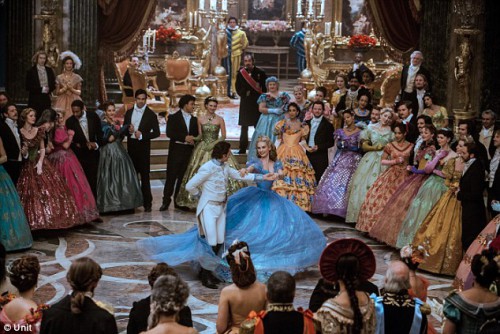
The glass slipper was designed based on an actual 1890 shoe, and fabricated by Swarovsky from crystal. It was made smaller than actual size for the model Cinderella holds. For the pair she slips on, these were actually of leather but replaced through CGI to appear as crystal.
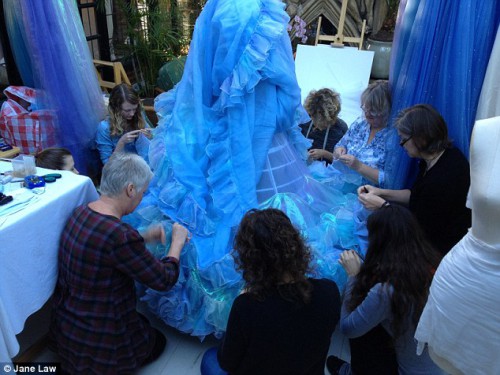
It takes a group of seamstresses to make an eleborate gown such as the Cinderella Ball Gown.
THE DANISH GIRL, designed by Paco Delgado is based on the groundbreaking case of the transgender surgery of Einar Wegener, a married man. His transformation into Lily Elbe is shown with the effects it had on him and his wife Gerda, a painter. It stars Eddie Redmayne and Alicia Vikander.

While posing as a model that didn’t show up for the job, Einar awakens a sense of his true womanly self. The couple stayed together and moved from Denmark to Paris where Gerda became a fashion illustrator.
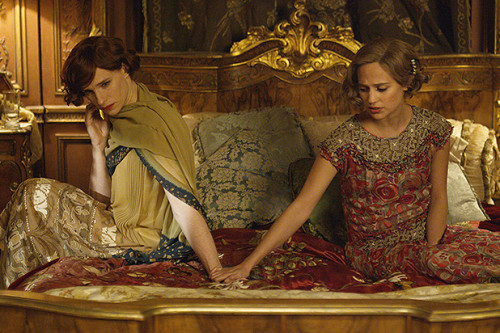
The silhouette of the 1920s was very flat-chested and narrow-hipped, which basically suited the dressing of star Eddie Redmayne, although he would have preferred more padding to accentuate curves. Designer Paco Delgado stated that all the curves were achieved through the cut of the costumes or through more volume at the chest or pleating. The fabrics were often taken from vintage dresses but had to be re-made for Eddie’s size. Paco Delgado used French fashion designers Jeanne Lanvin and Coco Chanel for period inspiration. This is Paco Delgado’s second Oscar Best Costume nomination, the previous time was for Les Miserables in 2012.

THE REVENANT was designed by Jacqueline West and starred Leonardo di Caprio and Thomas Hardy. Its the story of the frontiersman Hugo Glass that is left for dead by fellow trappers after being mauled by a bear. Still alive he vows revenge and seeks those who abandoned him. The movie was filmed in the frigid areas of Canada as directed by Alejandro G. Iñárritu.

“Alejandro wanted everything to look very real,” stated Jacqueline West. “Most of the hides came from first nations traders in Canada and we tried to age them by using animal fats and grease and that turned them rancid.” That was bad for the actors. It was West’s dyer/ager that came up with a home-made solution she called “black wax” that ended up being very successful. Soon the director had her stay on the sets all the time with her “black wax” at the ready.
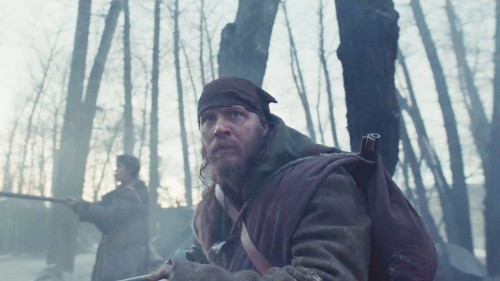
Tom Hardy had the heaviest costume in the movie. His coat consisted of double elk-skin, double-lined with beaver.
Jacqueline West has been nominated three times for a Best Costume Oscar. Her two previous nominations were for Quills (2000), and for The Curious Case of Benjamin Button (2008).
MAD MAX; FURY ROAD was designed by Jenny Beavan for stars Charlize Theron, Tom Hardy, and a cast of hundreds based on the graphic novel directed by George Miller. Beavan started out with an obvious challenge, the mechanical arm for Theron’s Imperator Furiosa character. Several leather shapes were cut-out and draped for what needed to be a key practical yet visually interesting piece. The harness and body suit was finally devised for her iconic look. Charlize Theron was very happy with her costume for the role. As to Theron’s shaved head, that was her idea, although the black grease on the forehead was a trait of the Imperators.

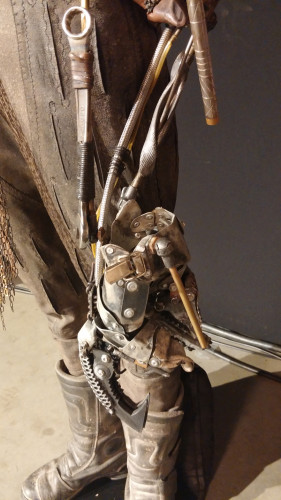
The Wives have always been protected and lived in a climate-controlled environment, and thus dressed unsuitably for the outside elements. Their costumes are made of white cotton and muslin body wraps and shorts.

The Warboys and Polecats also had their distinctive costumes, denoting their function and fearsome looks. Max also has shoulder-pads, a throw-back to the original Mad Max movie.
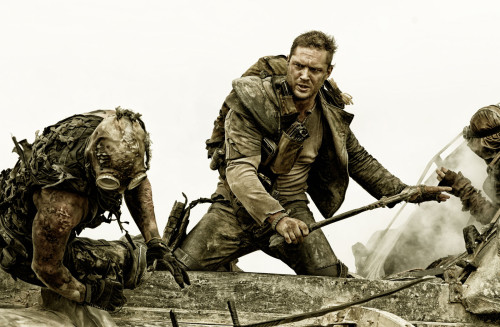
The Best Costume nominations are made by the Costume Designers Branch of the Academy. The Oscar is determined by vote of the entire Academy membership. Traditionally the memberships selects the big historical movies, or fantasies, and their costumes as favorites. Sandy Powell seems to be a favorite with two nominations. While Cinderella has a disadvantage of having been released earlier in the year, its lavish period costumes makes it a natural for the Academy voters. They receive a screening copy of the movie anyway to view for voting purposes. So I would predict Cinderella to be the Oscar winner for 2015 for designer Sandy Powell.

Many of the actual costumes from the nominated films are on exhibit at the Fashion Institute of Design and Merchandising ( FIDM) Museum in Los Angeles, February 9 through April 30.
Views: 255

